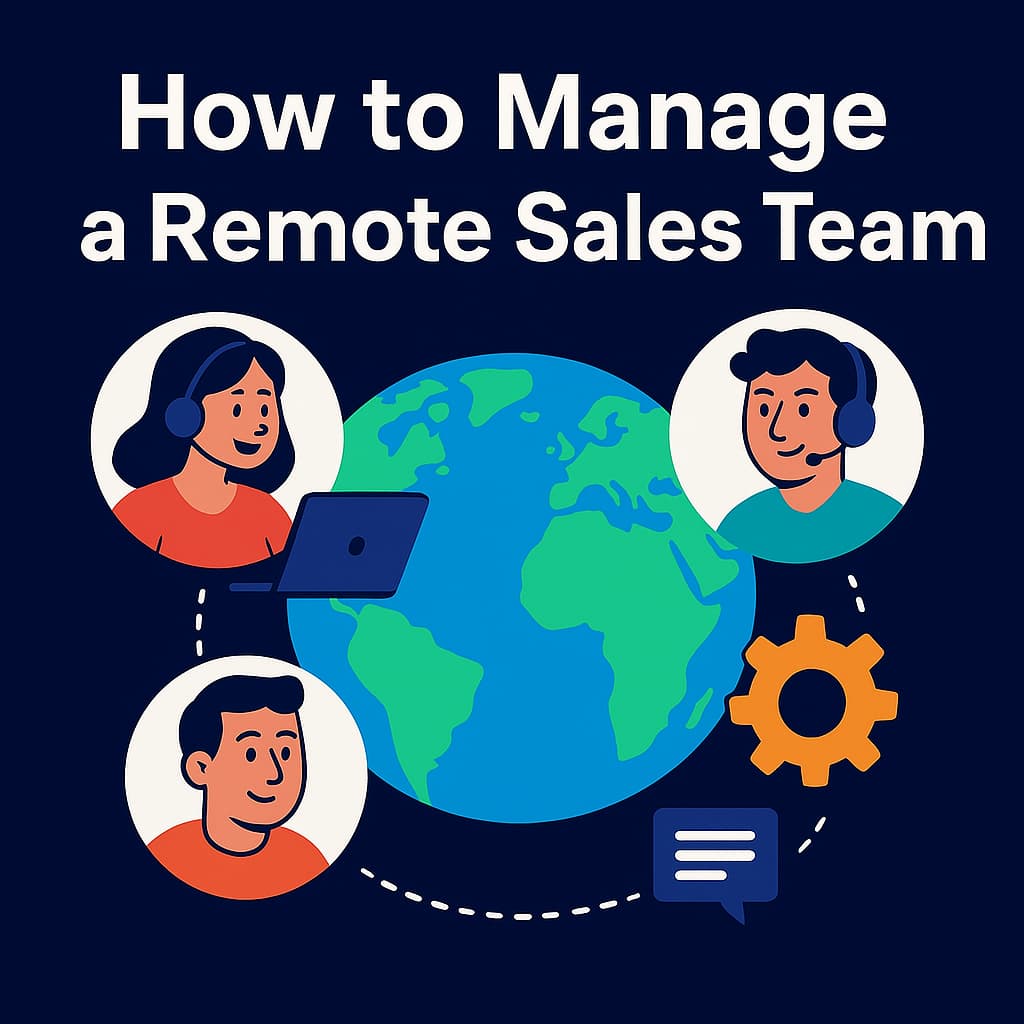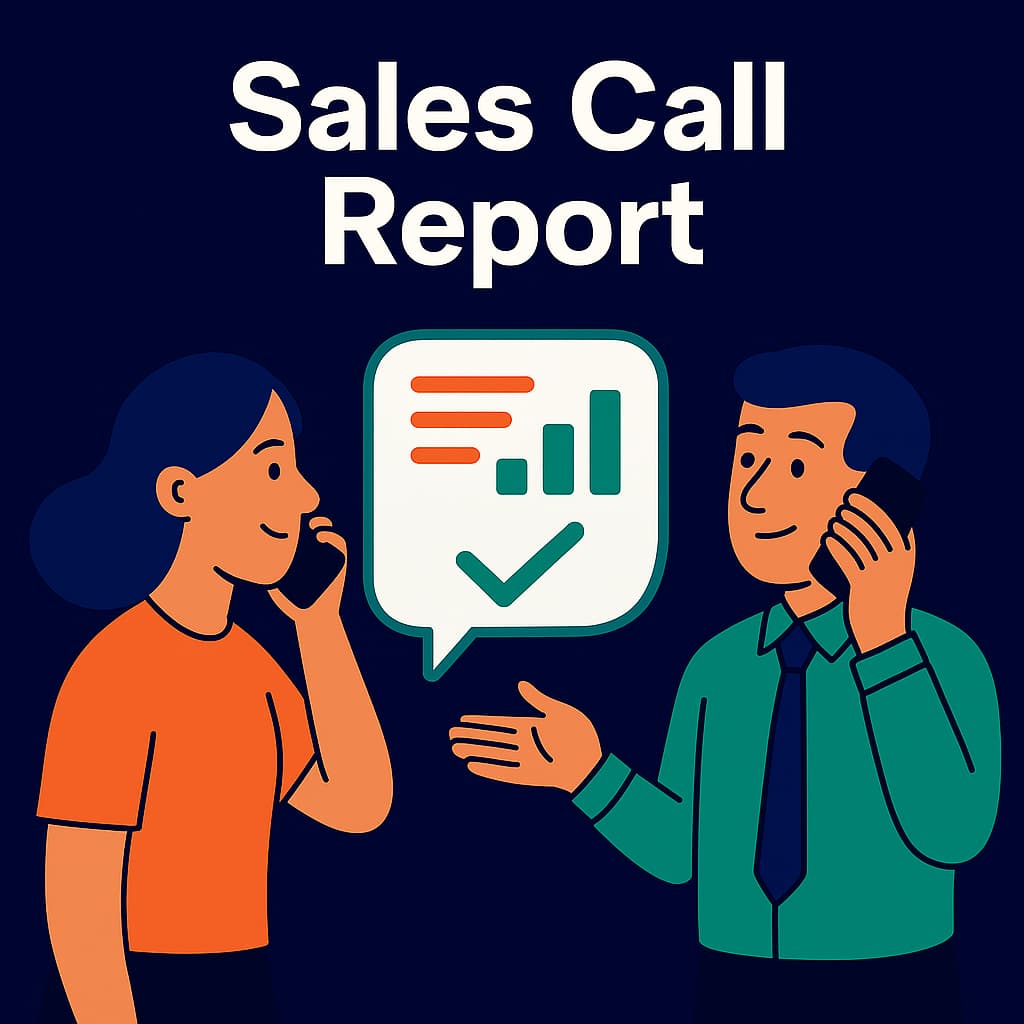
Sales Process Guide: 7 Steps to Higher Revenue
Here’s the uncomfortable truth: most sales reps spend only 33% of their time actually selling — the rest disappears into admin, meetings, and chasing unqualified leads (HubSpot, 2024). And it’s getting harder: 54% of sales professionals said selling became more difficult in 2024, citing longer deal cycles and fiercer competition (SEMrush 2024).
The culprit? Too many teams still operate without a documented, structured sales process. Companies with one generate up to 28% more revenue than those without (Harvard Business Review, 2024). That lack of structure is costly—but fixable.
In this guide, I’ll break down the seven essential steps of a modern sales process, highlight common mistakes that quietly kill deals, and show you how to adapt to today’s digital-first buyers.
What a Sales Process is and why your team needs one
Before we dive into the seven steps, let’s align on what a sales process actually is. Too often, teams confuse it with “methodology” or “pipeline.” They’re related, but not the same — and getting this definition right is the foundation for everything that follows.
Understanding the sales process definition
A sales process is the series of repeatable steps that guide reps from first contact with a prospect to a closed deal. Think of it as the what of selling—the roadmap every opportunity should follow.
It’s different from a sales methodology, which defines the how. Frameworks like BANT, MEDDIC, or SPIN tell you how to qualify or ask questions inside a stage. The process ensures those stages always happen.
Why does this matter? Because companies with a well-defined sales process see significantly higher revenue. As Mary Shea, former VP of Evangelism at Outreach, puts it:
There is still a big gap between how buyers want to buy and selling organizations’ ability to deliver those experiences.
Closing that gap starts with a process.
The business impact of implementing a structured sales process
A structured process isn’t red tape — it’s a growth lever. Teams that implement one see measurable improvements:
- Higher win rates. Reps know exactly what to do at each stage, so fewer steps get skipped.
- More accurate forecasts. Clear exit criteria mean your pipeline reflects reality.
- Less admin drag. Defined workflows and automation free up time.
- Scalability. Everyone follows the same playbook — from rookies to veterans.
Contrast that with today’s baseline: reps spend just a third of their time selling (HubSpot, 2024), while 54% say the job has grown harder year over year (SEMrush, 2024). Without a clear, structured sales process, inefficiency compounds.
That’s why leading teams embed their process into tools like CRM, Revenue Intelligence or Conversation Intelligence. These tools make each step visible within workflows, helping teams quickly spot blocked deals and identify winning or losing patterns in their pipelines.
The 7 essential steps of an effective sales process
A strong sales process is like a GPS: it shows where you are, what’s next, and how to avoid wrong turns. Without it, deals drift, timelines slip, and revenue suffers.
Here are the seven steps I coach: from prospecting to post-sale follow-up — benchmarks you can plug straight into your sales plan
The 7 Steps of a Sales Process (Quick Overview)
- Prospecting and lead generation — finding and attracting potential customers who fit your ICP.
- Initial contact and qualification — making first outreach and confirming if prospects are worth pursuing.
- Needs assessment and discovery — uncovering pain points, goals, and buying triggers through consultative questions.
- Solution presentation and demonstration — showing how your product solves the specific problems uncovered.
- Objection handling and negotiation — addressing concerns, reframing value, and building consensus to move forward.
- Closing the deal — securing commitment, finalizing contracts, and turning prospects into paying customers.
- Post-sale follow-up and account expansion — driving adoption, retention, and growth through ongoing success and upsell.
Step 1: Prospecting and lead generation
Prospecting is where everything starts. Identifying the right leads is the foundation — and too often where teams stumble.
- Define your ICP. Be precise about industry, size, tech stack, and triggers.
- Balance inbound/outbound. Outbound builds velocity; inbound warms the pipeline.
- Use the right tools. Automation softwares removes admin drag and scales outreach.
- Prioritize quality. Ten well-researched prospects beat a hundred cold emails.
The numbers back it up: 96% of buyers research before talking to sales (HubSpot, 2024). If you’re not visible where they’re searching, you’re already behind.
👉 Related reading: Market Trends help your team prospect where demand is rising, while AI-powered sales tools cut through noise with smarter targeting.
💡 Pro tip: Document your prospecting targets, messaging, and process. Reps should know exactly what a “good lead” looks like, where to find them, and how to reach out. That consistency is what turns a messy funnel into a repeatable one.
Step 2: Initial contact and qualification
First contact sets the tone — qualification decides if the deal is worth pursuing.
- Mix channels. Calls, LinkedIn, email — meet buyers where they are.
- Structure discovery. Use frameworks like BANT (Budget, Authority, Need, Timeline, or MEDDIC (Metrics, Economic buyer, Decision criteria, Decision process, Identify pain, Champion), or CHAMP (Challenges, Authority, Money, Prioritization) so reps focus on qualified opportunities.
- Ask smart questions. Prioritize triggers and timing, not just budget.
- Map the committee. B2B deals involve an average of five decision-makers (HubSpot, 2024).
This is where a standardized process saves you from chasing bad-fit opportunities and helps you focus on the ones that truly match your ICP.
Sample qualification questions
Use these live, not as a script:
- Trigger & timing: “What changed internally that made this a priority now?”
- Impact: “If nothing changes this quarter, what breaks?”
- Authority: “Who else will weigh in on the decision, and what will they care about?”
- Budget: “Is there a range you’re targeting, or should we scope first and price second?”
- Process: “What steps usually happen between a demo you like and a signed agreement here?”
- Risks: “What would make this initiative stall?”
These questions qualify fit and path to value — so the process moves opportunities forward with purpose, not hope.
⚡ Quick tip: document your discovery questions in the CRM. That way, reps don’t wing it, managers can coach, and insights flow back into pipeline reviews.
👉 Related reading: BANT vs MEDDIC — which framework fits your team?
Step 3: Needs assessment and discovery
Discovery is where real selling begins — when you uncover the problems behind the symptoms.
- Go deeper. Don’t stop at surface pain; identify root causes.
- Listen for emotion. Fear of missing targets drives urgency more than features.
- Align with the buying journey. Good discovery mirrors how buyers evaluate solutions.
- Document everything. Feed insights into your sales playbook.
- Build trust. Discovery is a dialogue, not an interrogation.
💡 As I tell my teams: “Show me a weak discovery, and I’ll show you a deal that drags forever — or dies quietly.”
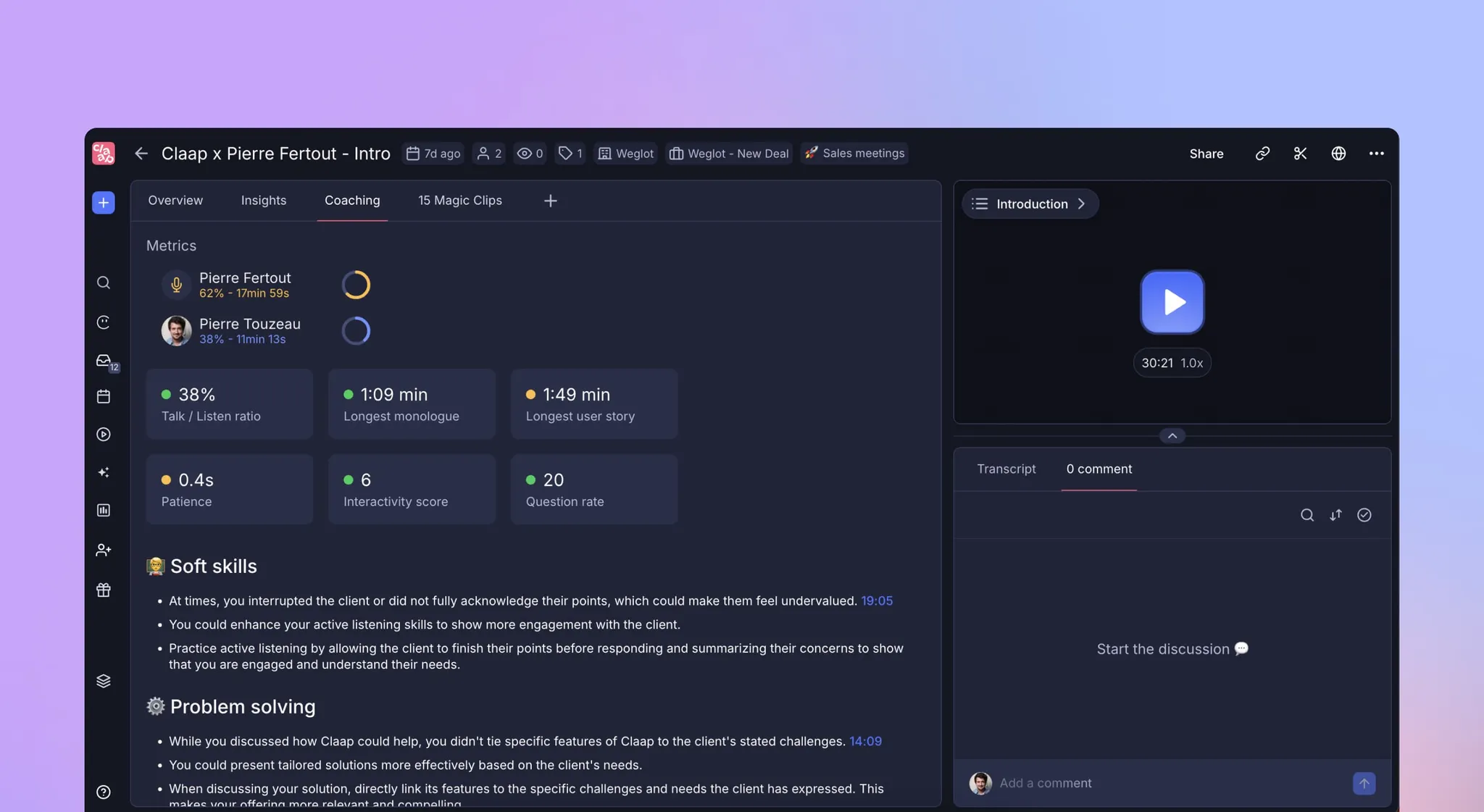
👉 Related reading: Claap sales coaching software captures insights by recording and analyzing discovery calls, so managers can coach to the right gaps.
Step 4: Solution presentation and demonstration
This is where your pitch comes alive. Your demo should feel like their story, not your deck.
- Focus on pain points. Tie features back to discovery.
- Tell a story. Walk them through a day with your solution.
- Bring proof. Case studies and benchmarks reduce risk.
- Handle technicals early. Loop in experts before momentum stalls.
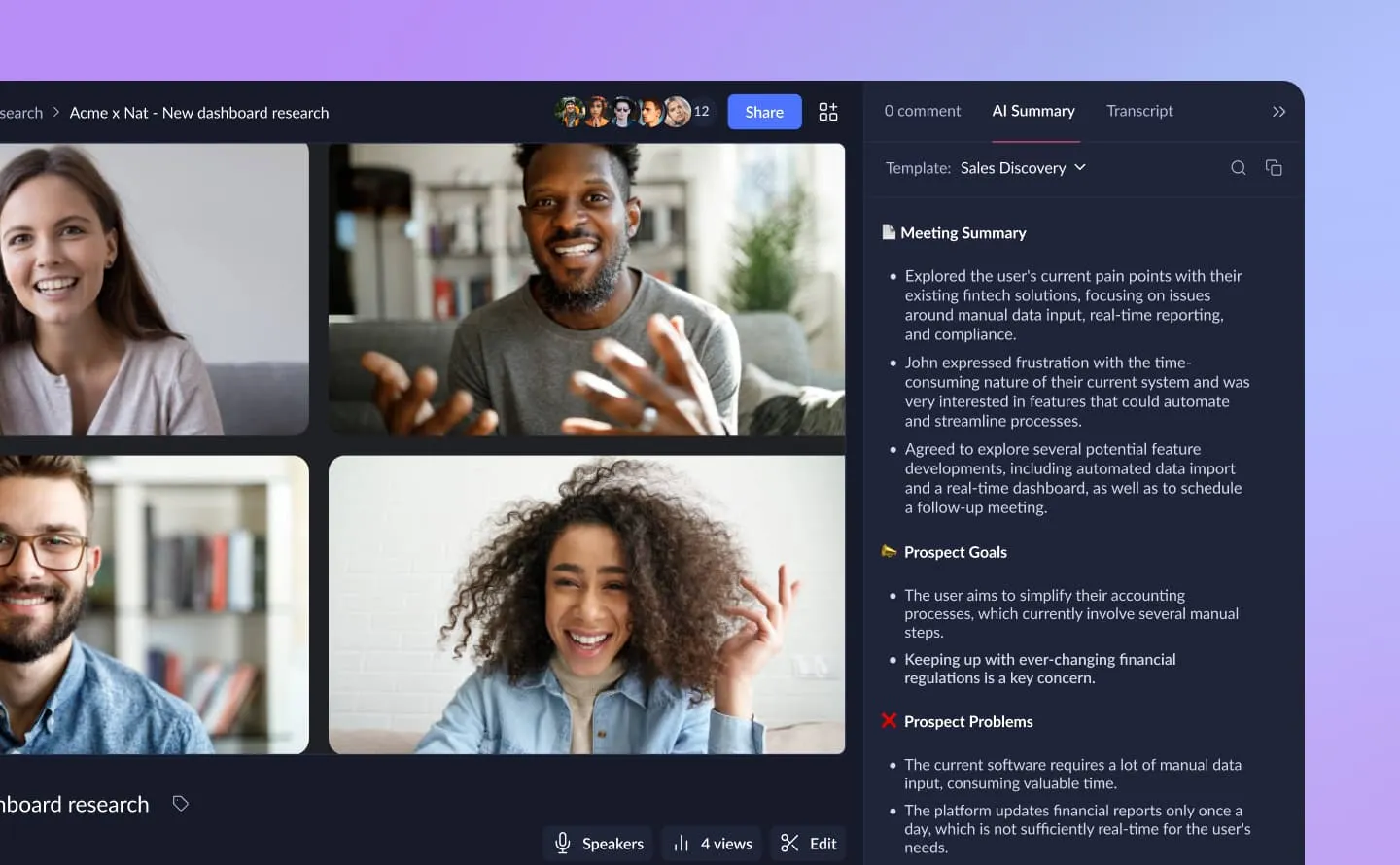
💡Pro Tip: record your demos and share highlights. Stakeholders who couldn’t join live can see the value in context — and you control the narrative.
Step 5: Objection handling and negotiation
Objections aren’t stop signs — they’re signals.
- Anticipate the classics. Price, competition, implementation.
- Reframe to value. Shift conversations back to outcomes.
- Negotiate smart. Bundle services instead of cutting price.
- Build consensus. Equip champions with talking points.
28% of sales pros say lengthy processes are the top deal-killer (SEMrush, 2024). Logging objections in your CRM helps teams preempt them with enablement content and targeted coaching.
Common objections & responses
- “Price is high.”
→ Anchor on ROI: “We scoped a 12% lift in conversion and 20 hours/month saved. Even half of that pays back in X months. Want to adjust scope instead of value?”
→ Check their Budget: “What would fit in your budget and should we limit some seats or features?” - “We’re using/preferring another tool.”
→ Probe gaps: “What’s working and what’s not? We often co-exist or replace when [gap] matters. Want to compare side by side?” - “No bandwidth to implement.”
→ De-risk: “That’s why we do a ‘minimum viable rollout’—one team, one metric, 30 days. We handle setup. If it doesn’t earn its keep, we stop.”
Handle objections as value clarification, not price defense. It shortens cycles and helps you close deals without discounting.
⚡ Quick tip: log every objection. Patterns emerge, marketing creates collateral, and cycles shorten without discounting.
Step 6: Closing the deal
Closing is about clarity, not pressure.
- Spot buying signals. Questions about next steps = readiness.
- Pick your close. Summary vs. assumptive, depending on context.
- Remove friction. Digital contracts and e-signatures cut weeks of delay.
- Tie urgency to reality. Budget cycles, compliance, go-live dates.
Your goal is to keep your pipeline predictable and flag at-risk deals before procurement stalls them.
💡Pro Tip: align on approval paths before sending contracts. Many “sure things” stall because legal or finance weren’t looped in.
Step 7: Post-Sales Follow-Up and Expansion
The contract isn’t the finish line — it’s the starting line for growth.
- Onboard with intent. A smooth launch builds confidence fast.
- Stay close. Regular check-ins uncover new needs.
- Expand strategically. 72% of revenue comes from existing customers (SEMrush, 2024).
- Enable self-service. Teams with it are 47% more likely to exceed quota (HubSpot, 2024).
Revenue Intelligence spots expansion triggers, while leading RevOps Teams turn post-sale into a growth engine.
Post-sale playbook
- Onboarding (Weeks 0–2): success plan, setup, first milestone.
- Adoption (Weeks 3–6): usage goals by role, enablement sessions.
- Value & Satisfaction review (Day 45): usage vs. goals, risks, commitments.
- Expansion (Day 60+): second use case, additional team, or feature set.
⚡ Quick tips:
- Treat post-sale as another stage in your process — not an afterthought.
- Focus on NPS first to turn new customers into champions of your solution.
- Document activities, assign owners, and measure outcomes. Regular check-ins improve satisfaction and boost customer lifetime value.
Sales process optimization strategies for modern buyers
The seven-step framework still works — but today’s buyers don’t behave like they did even five years ago. They research more, expect more, and talk to sales later in their journey. If your process hasn’t adapted, you’re already behind.
Adapting to digital-first buyer behavior
Today’s buyers are self-directed: 96% research independently and 71% prefer digital-first engagement (HubSpot, 2024).
To meet them where they are:
- Offer self-service. Product tours, reviews, FAQs, and customer stories build trust before the first call.
- Use async updates. Video recaps and digital sales rooms keep momentum when stakeholders can’t align schedules.
- Engage across channels. Buyers don’t want “spray and pray” — they want consistency across LinkedIn, email, and calls.
- Lead with video. Short, targeted clips often perform better than long emails.
As HubSpot’s Chief Sales Officer Christian Kinnear notes:
Sellers want to sell, but research shows they spend just 33% of their time actively selling.
The more you design for how buyers actually buy, the less wasted effort on both sides.
Leveraging AI and automation in your sales process
AI is no longer optional — it’s table stakes. Teams that integrate it into their workflows report:
- Lead scoring. AI prioritizes ICP matches automatically.
- Automated follow-up. Keeps deals moving without manual chasing.
- Predictive analytics. Flags risks and opportunities early.
- Time savings. AI cuts ~2 hours of admin per rep per day (HubSpot, 2024).
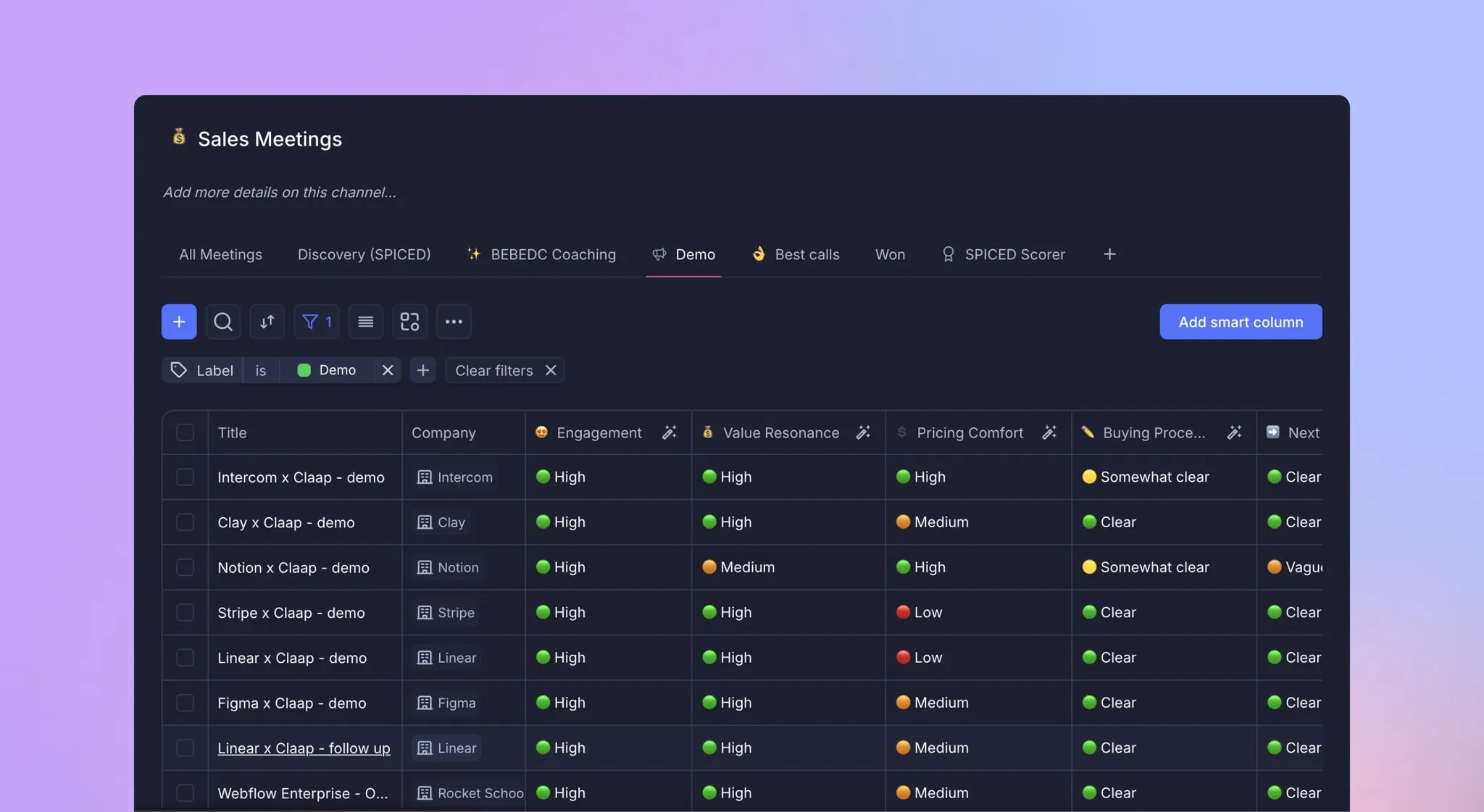
Companies using AI in sales report 76% higher win rates and 78% faster closes (Martal, 2024). That’s not just a productivity hack — it’s a competitive advantage.
⚡Quick tips:
- Tie AI into your existing stack. If reps have to log into five different systems to find insights, adoption will stall. Integrations keep process and productivity aligned.
- Find a “tech-savvy” champion within your team (or involve RevOps for larger teams) to test new AI tools, build AI agents that improve existing processes, and unlock rep productivity.
Sales process examples and templates you can use today
Example 1: 7-stage SaaS process (mid-market)
Prospect → Qualified → Discovery → Demo → Proposal → Commit → Closed/Won
- Exit criteria highlights: ICP match + trigger, multi-threaded contacts, quantified business case, security checklist cleared, legal/procurement steps mapped.
Example 2: Manufacturing process (RFP-heavy)
Prospect → Technical Discovery → Site Visit → RFP → Pilot → Commercial Review → Award/PO
- Exit criteria highlights: technical requirements captured, safety/compliance verified, pilot acceptance criteria, total cost of ownership model approved.
Templates to copy:
- Qualification question bank (add to CRM required fields).
- Demo narrative outline (pain → day-in-the-life → proof).
- Objection log (tag by stage + persona).
- Post-sale cadence (onboarding → adoption → QBR → expansion).
If you need a fast start, use your CRM to embed these as fields + tasks. Then layer in insights from conversation intelligence to coach against real calls.
Common mistakes and how to avoid them
Even with the best intentions, most teams trip up on the same roadblocks. The good news? Once you spot these mistakes, they’re easy to fix.
Lack of ICP & key questions
You can’t qualify what you haven’t defined. Too many reps chase anyone who looks interested — and then wonder why deals stall. Without a clear Ideal Customer Profile (ICP) and a standard set of discovery questions, your pipeline fills with noise.
Frameworks like SPICED, MEDDIC, or BANT give reps a consistent way to evaluate fit. If everyone qualifies differently, you don’t have a process — you have chaos.
👉 Related resource: SPICED Scorer — an AI assistant that ensures every discovery call follows the same playbook.
Process implementation pitfalls
A sales process isn’t valuable if it lives in a slide deck no one opens. Common traps include:
- Over-engineering with too many steps.
- Failing to align with the buyer journey.
- Training once a year, then forgetting.
- Never running quarterly reviews.
Remember: the process should help reps, not weigh them down. If it feels like red tape, adoption will tank.
When your sales process makes you look like just a vendor
If discovery is shallow and your demo is generic, buyers slot you as just a vendor. Symptoms: chasing demos without a business case, discounting to force momentum, and ghosting after procurement requests “more info.”
Fix it by anchoring every step in the buyer’s journey: a business problem, an executive-level outcome, and a quantified success plan. That’s how a winning sales process earns consensus and avoids death by committee.
Execution and consistency challenges
Even a strong design can fail in execution. Top culprits include:
- Poor CRM adoption: Data never gets updated.
- Inconsistent messaging: Each rep improvises.
- Skipping steps: Deals get rushed and stall later.
- No measurement: Without KPIs, you’re flying blind.
No surprise: 45% of sales professionals say they feel overwhelmed by the number of tools in their stack (SEMrush, 2024). Streamlining tools and embedding your process directly into the CRM goes a long way toward making consistency possible.
⚠️ Quick tip: don’t just document the process — enforce it. Define exit criteria for each stage so reps can’t skip steps when a deal “looks good.”
Measuring and optimizing your sales process performance
A sales process isn’t “set and forget.” To know if it’s working, you need to measure it like you’d measure a marketing funnel or product roadmap.
Key metrics and KPIs to track
Your process is only as strong as the numbers behind it. Here are the essentials sales metrics :
- Stage-to-stage conversion rates. How many prospects move from discovery to demo? From demo to proposal? Spot where deals leak.
- Average sales cycle length. SMB = 2–6 weeks, mid-market = 1–3 months, enterprise = 3–6+ months. Urgency drivers (like compliance deadlines) can shorten cycles dramatically.
- Average deal size. Are you winning the right kind of business — or just small, quick wins?
- Win rate. The gold standard. Across industries, the median is 21% (HubSpot, 2024).
- Activity metrics. Calls, emails, meetings — useful only if tied back to outcomes.
Key benefits of tracking sales performance
Why this discipline matters:
- Focus. Stage conversion data shows where the sales funnel leaks, so managers coach the right moments.
- Forecasting. A consistent average deal cycle and defined win rates turn guesses into models finance can trust.
- Prioritization. Activity tied to outcomes clarifies which sales efforts move revenue — and which are noise.
- Accountability. Clear targets per stage create shared expectations across the sales team.
The real benefit: a streamlined sales process that compounds learning every quarter.
Continuous improvement strategies
Top sales teams don’t just run a process — they refine it constantly. Here’s how:
- Quarterly reviews. Sit down as a team, analyze conversion data, and adjust criteria.
- A/B testing. Trial new email cadences, demo formats, or qualification frameworks. Keep what works, drop what doesn’t.
- Win/loss analysis. Talk to customers you won and lost. Their feedback is the fastest way to spot gaps and fix them.
- Tech audit. If reps log into ten tools but only use three, simplify. Adoption beats shiny features every time.
The takeaway: processes are living systems. They evolve with your buyers, your market, and your team’s feedback. If yours hasn’t changed in the last 12 months, it’s probably out of date.
Sales process technology and CRM integration
A sales process is only as strong as its execution — and execution lives inside your tech stack. The best processes aren’t written in PDFs; they’re embedded into CRM systems and supported by tools reps actually use.
Building your process into CRM systems
Your CRM is the engine room of the sales process. If it doesn’t reflect your stages and criteria, reps will go off-script.
Here’s how to lock it in:
- Define clear stages. Each stage should mirror one of your seven steps, with explicit exit criteria (e.g., “Budget confirmed” before moving past qualification).
- Automate the admin. Use workflows to auto-assign tasks, trigger reminders, and update fields. That way, reps spend more time selling, less time logging.
- Customize fields. Capture the details that matter: decision-maker roles, deal blockers, use cases.
- Build dashboards. Pipeline visibility matters only if you can see conversion rates, cycle lengths, and forecast accuracy in one view.
Think of CRM not as a database, but as your live playbook.
Essential sales technology stack components
Beyond CRM, every modern sales team needs a supporting cast. Keep it simple, but cover these categories:
- CRM platform. Salesforce, HubSpot, or Pipedrive — your single source of truth.
- Sales engagement. Sequencing tools for multi-channel outreach.
- Proposal & contract management. E-signature platforms that remove weeks of delay.
- Analytics & forecasting. Solutions that surface pipeline health, deal risk, and conversion benchmarks.
- Conversation intelligence. Tools like Claap capture and analyze sales calls so insights and coaching flow across the whole team.
🛠️ Quick tip: Map each tool to a specific stage of your sales process. If it doesn’t directly help a rep move a deal forward, question whether you really need it.
A structured sales process isn’t bureaucracy — it’s the engine of predictable growth. Teams that run a clear, buyer-aligned framework win more deals, forecast with confidence, and build stronger customer relationships. The key is execution: turning process from a slide deck into daily practice.
FAQs
What are the 7 steps in the sales process?
The seven steps are prospecting, qualification, needs assessment, presentation, objection handling, closing, and post-sale follow-up. This framework gives your team structure and repeatability.
How long should each stage of the sales process take?
Timelines depend on deal size. SMB cycles often close in 2–6 weeks, mid-market in 1–3 months, and enterprise deals can stretch to 6+ months. Complexity adds time — multiple stakeholders, compliance reviews, or contract negotiations. On the flip side, urgency drivers like audits or regulatory deadlines can cut cycles sharply, even for large deals.
What's the difference between a sales process and sales methodology?
A sales process defines the what — the steps reps follow from first contact to close. A methodology defines the how — the approach used inside those steps, such as SPIN, MEDDIC, or Challenger. Think of process as the map and methodology as the driving style. Both are essential for consistent execution.
How do I know if my sales process is working?
Track conversion rates between stages, average cycle length, and win rates. Benchmarks help: across industries, the median win rate is 21% (HubSpot, 2024). If deals move predictably through stages, forecasts align with results, and revenue grows, your process is delivering. If not, it’s time for a review.
Should every deal follow the exact same sales process?
The framework should be consistent, but execution flexible. Every deal should follow the seven stages, but the time spent in each will vary based on buyer needs and deal complexity. For example, enterprise deals may require a lengthy discovery, while SMB deals may accelerate straight from qualification to demo.
How often should I review and update my sales process?
Formally review quarterly, with smaller tweaks monthly. Markets shift, buyer behavior evolves, and processes age quickly. Harvard Business Review (2024) found that optimizing sales process steps can lift win rates by up to 28%. If your process hasn’t been updated in the last year, it’s already outdated.
What tools do I need to implement a sales process?
At minimum: a CRM to track stages, sales engagement tools for outreach, and analytics to measure performance. Teams that add AI-driven automation save ~2 hours per rep per day and see significantly higher win rates (HubSpot, 2024). Conversation Intelligence Tools like Claap integrate directly into daily workflows, keeping processes consistent.
How do I get my sales team to actually follow the process?
Make it easy and enforced. Train reps, document steps inside the CRM, and set clear exit criteria for each stage. Managers should coach consistently, and dashboards should reflect progress. When the process is the fastest path to closing deals, adoption follows naturally.
What's the most important step in the sales process?
Discovery. A weak discovery leads to misaligned demos, stalled deals, and lost revenue. A strong one surfaces pain points, buying triggers, and emotional drivers — the foundation for the entire deal. In B2B sales, understanding the problem matters more than presenting the solution.
How do modern buyers want to engage with sales processes?
Buyers want self-service resources, digital interactions, and consultative conversations. With 96% researching independently and 71% preferring digital-first engagement (HubSpot, 2024), your process must adapt. That means enabling product tours, async updates, and customer proof — while training reps to be guides, not pitch machines.
.jpg)
